Mad Hedge Biotech & Healthcare Letter
November 26, 2019
Fiat Lux
Featured Trade:
(WHY KARUNA THERAPEUTICS IS THE BIG ONE THAT GOT AWAY),
(KRTX)

Mad Hedge Biotech & Healthcare Letter
November 26, 2019
Fiat Lux
Featured Trade:
(WHY KARUNA THERAPEUTICS IS THE BIG ONE THAT GOT AWAY),
(KRTX)

In many respects, buying the shares of small biotech companies is a lot like purchasing lottery tickets. Look no further than Karuna Therapeutics (KRTX), which has just soared sevenfold on the back of wildly successful phase II trials for its schizophrenia drug KarXT.
While it is too late to buy (KRTX), it is illustrative of what is going on in the space with ever-increasing frequency. And the great news for you and me is that biotech is only months into a meteoric move that could last for decades.
KarXT is the next “gamechanger” in the field of schizophrenia. Why is this important? In the United States alone, schizophrenia already affects roughly 2.7 million people or almost 1% of the population. Needless to say, this condition makes handling relationships and maintaining jobs virtually impossible.
With its tendency to become a recurring condition as one of its key defining features, schizophrenics need recurring treatment as well. To make matters worse, the conditions are distinct from one patient to another. Hence, it no longer comes as a surprise that over a third of people afflicted by this condition do not respond to the antipsychotic treatments available in the market today.
As for the treatments that do take effect, the side effects associated with the drugs also hinder the day-to-day activities of the patients causing them to discontinue taking it altogether. Currently, one of the most popular antipsychotic drugs used to treat schizophrenics is Johnson and Johnson’s (JNJ) Invega Sustenna. Based on its 2019 revenues so far, the drug is projected to be on pace to hit the projected sales of $3.3 billion by the fourth quarter.
In comparison, Karuna’s KarXT functions on muscarinic receptors that respond to acetylcholine, which is basically an organic chemical found in the brain. Meanwhile, JNJ’s drugs focus on dopamine and serotonin receptors. This primary difference between the two drugs puts Karuna’s drug on the lead. However, Karuna is not the first in looking into muscarinic receptors. In 2016, Allergan (AGN) paid Heptares Therapeutics $3.3 billion in an effort to license drugs similar to KarXT.
What really inspired excitement though is the tolerability of KarXT. Since the majority of antipsychotic drugs on the market today are notorious for their adverse effects, Karuna’s drug achieved a discontinuation rate of only 20% -- an impressive result considering that the placebo group had a 21% discontinuation rate. More impressively, KarXT users did not experience any of the commonly feared side effects like weight gain or drowsiness.
Aside from schizophrenia, Karuna is also looking into ways to use KarXT as a treatment option for other CNS disorders that can offer none of the debilitating side effects of current antipsychotic drugs. This could cover treatments for Alzheimer’s disease and even for pain management.
Following this exciting revelation, Karuna announced its intention to conduct a public offering of 2.6 million shares in an effort to raise additional capital. All things considered, the small biotech company has been moving at a notable pace. Just last June, this PureTech-backed company opened with a $75 million IPO -- a humongous jump from its initial price point of $42 million.
So far, the companies competing in the same space as Karuna are Novus Biologicals, Anavex, and TheraVida.
The next important step for Karuna is its meeting with the FDA in the second quarter of 2020, which is anticipated to push KarXT to Phase 3 of its clinical trial. If all goes well, this phase will be launched in the latter part of 2020.
Volatility is always to be expected particularly when investing in biotech companies. Karuna’s amazing news demonstrates why volatility can sometimes be a good thing. Although there are more trials and testing to be performed, the results of KarXT’s study should put Karuna on the hot list of biotech investors.
While this one got away, the Mad Hedge Biotechnology and Healthcare letter has a long list of letters coming promising similar potential.
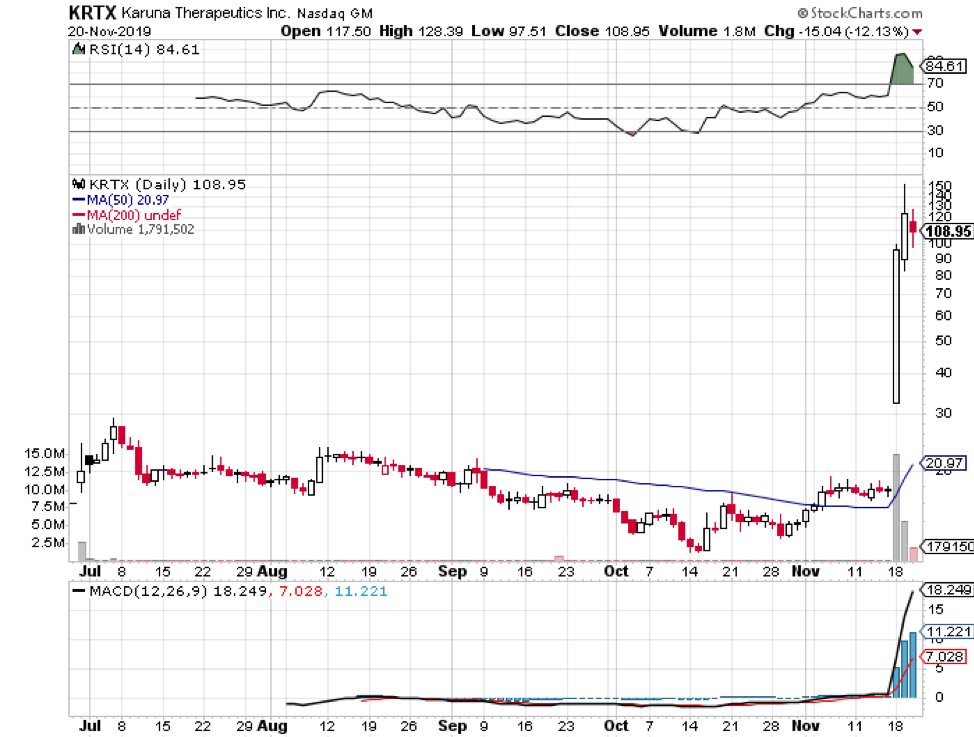

Mad Hedge Biotech & Healthcare Letter
November 21, 2019
Fiat Lux
Featured Trade:
(WHY VERTEX HAS BEEN ON FIRE),
(VRTX), (CRSP)

Vertex Pharmaceuticals Inc. (VRTX) is the unequivocal king of the genetically rare lung condition cystic fibrosis (CF). To further prove its stronghold of the market, the company recently received FDA approval for its fourth CF treatment called Trikafta — five full months ahead of schedule and merely three months following the company’s application.
In a few weeks, the drug will be available in pharmacies, carrying a price tag of $311,000. This puts Trikafta somewhere in the range of another prized Vertex CF treatment, Kalydeco.
Sales of this newest drug is estimated to reach $4.6 billion by 2023 and more than $6.6 billion by 2025, with the drug projected to hit its peak at $10 billion by the second half of 2020. Hence, this latest addition to Vertex’s pipeline practically guarantees the company’s supremacy over the lucrative multi-billion dollar sector for the next decade or so. More importantly, sales from this CF drug could — at the very least — double the annual revenue of Vertex.
The projected earnings of Trikafta places it in the blockbuster tier as early as 2020, with the drug anticipated to be marketed as a treatment with a “whole new level” of efficacy compared to the earlier CF medications released by Vertex. With this new addition, the company can now reach 90% of CF patients in the United States — a huge leap from 50% it’s currently allowed to treat.
However, the launch of Trikafta is a bittersweet deal with Vertex as sales of older treatments are anticipated to weaken. In particular, the company expects Symdeko and Orkambi to eventually fade away from the market as more and more patients opt for the newer and more potent Trikafta.
Despite the impending success of Trikafta, it appears that Vertex has no intention of letting up. Since its CF products have translated into healthy profits in the past four quarters and a whopping $950 million in the third quarter alone, it’s no wonder the company continues to work on new offerings for this market.
Even with the weakening sales of Symdeko, the performance of the CF drugs in the most recent earnings report showed a 21% jump over the same period in 2018. To date, the company has three additional treatments submitted for Phase II trials.
Beyond the CF realm, Vertex has also been looking to expand in other sectors. One of its exciting partnerships is with gene-editing company CRISPR Therapeutics (CRSP). The two companies have been working closely to come up with game-changing treatments that could pioneer therapies for rare conditions like sickle cell disease, Duchenne muscular dystrophy, and beta thalassemia. All three of these orphan designation drugs have the potential to turn into blockbuster treatments.
For 2019, Vertex projects a product revenue somewhere between $3.70 billion to $3.75 billion. Meanwhile, its full-year earnings per share is estimated to be $4.77, which is a 17% increase from last year’s report.
A clear downside of Vertex is the fact that it’s one of the most highly valued stocks in the biotech industry at 31.1 times forward earnings. Nonetheless, a long-term study of the company’s performance would show that the shares are actually grossly undervalued even at their present-day levels. After all, this biotech stock has the potential to triple or even quadruple its yearly revenue over the next five years or so especially if its partnership with CRISPR Therapeutics comes into fruition.
Overall, the growth and profitability profile of Vertex makes it an attractive stock to own. Add to that its promising pipeline, and you have one of the most attractive names in the biotech sector. Hence, now is the ideal time for investors to buy Vertex shares as you can confidently bet on its dominance on the CF market as well as its exciting gene-editing ventures and potential revenue stream.
Don’t chase Vertex up here but buy the next substantial dip.
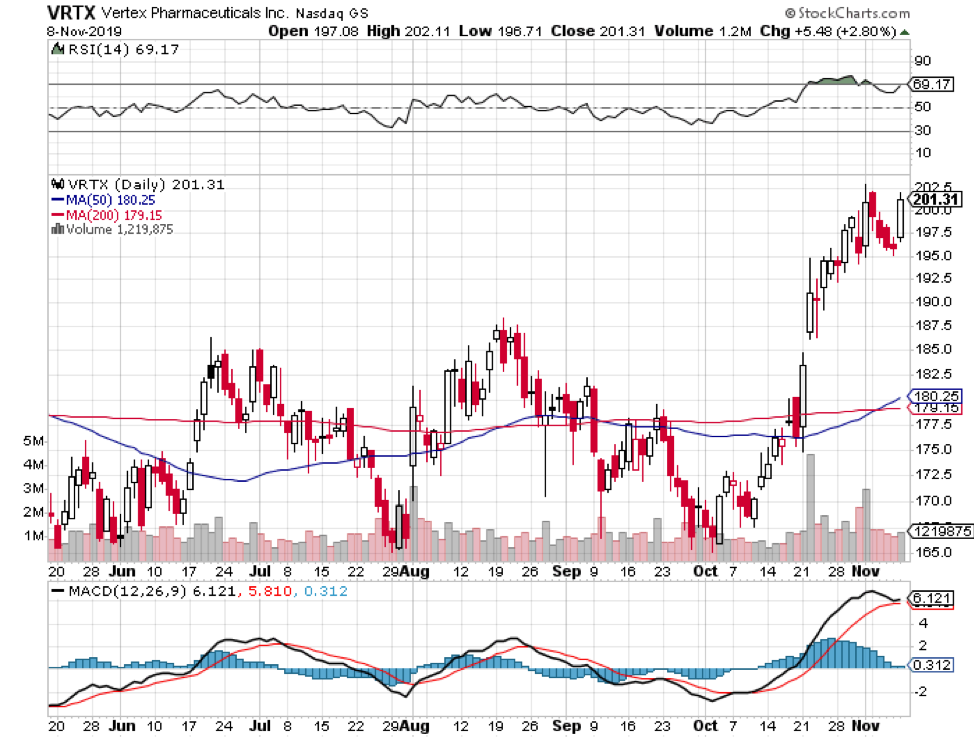
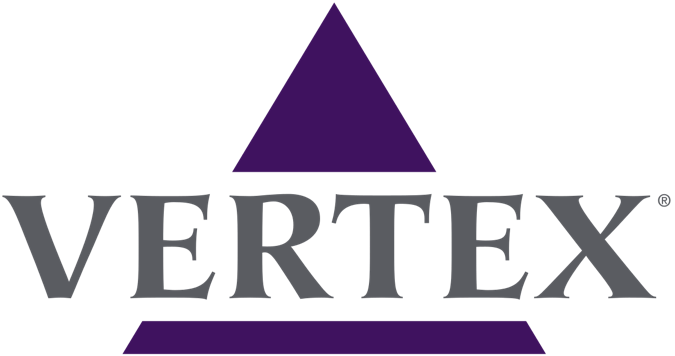
Mad Hedge Biotech & Healthcare Letter
November 19, 2019
Fiat Lux
Featured Trade:
(TAKE A WALK ON THE WILD SIDE WITH GENE EDITING),
(EDIT), (NTLA), (CRSP), (VRTX), (REGN), (NOVN)

No other industry has inspired fear as much as the biotech world, and no other sector of the biotech industry has garnered such mixed reactions as the gene-editing group.
At the moment, the public has been grossly undervaluing the three major companies that actually hold the power to control the foundational patents for CRISPR-CAS9 — the gene-editing technique with the greatest potential to dominate the biotech industry. These overlooked Big 3 companies are Editas (EDIT), Intellia Therapeutics (NTLA), and CRISPR Therapeutics (CRSP).
There are distinct differences between these three pioneering biotech firms. With a market value of $2.7 billion, Crispr Therapeutics (CRSP) is the first company to venture into clinical trials, attracting Vertex Therapeutics (VRTX) as one of its major investors. Editas, which has a market cap of $1.3 billion, is a close second to Crispr Therapeutics in terms of clinical trials. Despite the issues plaguing its executive department lately, the company is anticipated to eventually land a big partner to help fund its research as well.
Then there's Intellia Therapeutics (NTLA). The company, which has a market cap of $850 million, is considered the laggard in the CRISPR gene-editing world. What further fuels the ambivalence of investors is the expectation that clinical trials for its lone drug candidate won't be ready until 2020 or even 2021. The lack of flashy updates from Intellia Therapeutics has several investors wondering if this low market cap company is actually a good buy.
In its third-quarter earnings report though, Intellia Therapeutics posted revenues worth $10.62 million — a jump from the $7.41 million recorded during the same period in 2018. Aside from that, the company managed to attract Novartis AG (NOVN) as one of its major investors. Recently, the company also established a partnership with Regeneron Pharmaceuticals (REGN), which is viewed as a promising step towards bolstering Intellia Therapeutics’ growth.
Based on their recent updates, Regeneron and Intellia Therapeutics are working on NTLA-2001. This is a treatment for a rare disease called transthyretin amyloidosis (ATTR), also known as a protein misfolding disorder which causes an abnormal protein buildup in the body's organs and tissues.
While this has yet to reach human trials, the preclinical studies involving non-human primates showed an over 95% reduction of the protein in the patient's liver. Since this disease requires chronic dosing throughout the lifetime of the patient, the success of NTLA-2001 has an incredible disruptive potential for one-shot treatments of ATTR. Apart from that, this treatment will position Intellia Therapeutics as the sole dominating force in this gene-silencing sector.
As things stand today, Intellia Therapeutics may seem as if it has been straggling behind Crispr Therapeutics and Editas. However, the promising plans of the company may prove this statement false. While its move to take its time before pulling the trigger on NTLA-2001 may be frustrating for investors eager to see the results, the recent developments show that this was a necessary precautionary measure to protect the company’s potentially revolutionary delivery system. Despite the delay, this move could translate to dividends across all the drugs and treatments in Intellia Therapeutics’ pipeline in the next years.
Despite their status of being on the verge of discovering treatments for the incurable diseases, it’s baffling to watch how investors continue to sidestep these Big 3 companies, which have a measly $5 billion valuation among all three of them.
Gradually though, a number of forward-thinking investors are starting to shift out of growth names and turn into more defensive investment strategies. With this switch in style slowly making its way to the public, more and more biotech stocks are revealed to be extremely undervalued — and it’s only a matter of time before the likes of Crispr, Editas, and Intellia become a household name among investors.
While the biotech industry can be a scary place to invest in, the key to succeeding in this sector is understanding the market. It’s also advisable to diversify your portfolio. However, bear in mind that not all portfolios chock full of trials in their pipeline guarantee success. At times, a company only needs one or two promising treatments that can eventually serve as the stepping stone to 30 or more moneymakers.
Buy Intellia Therapeutics on dips, as it is the cheapest of the lot.
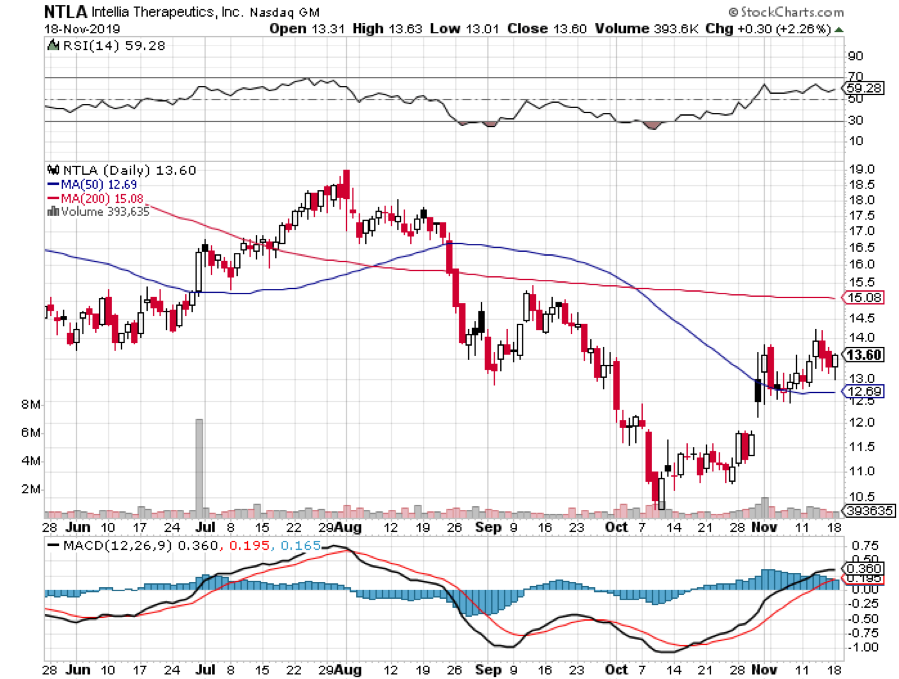
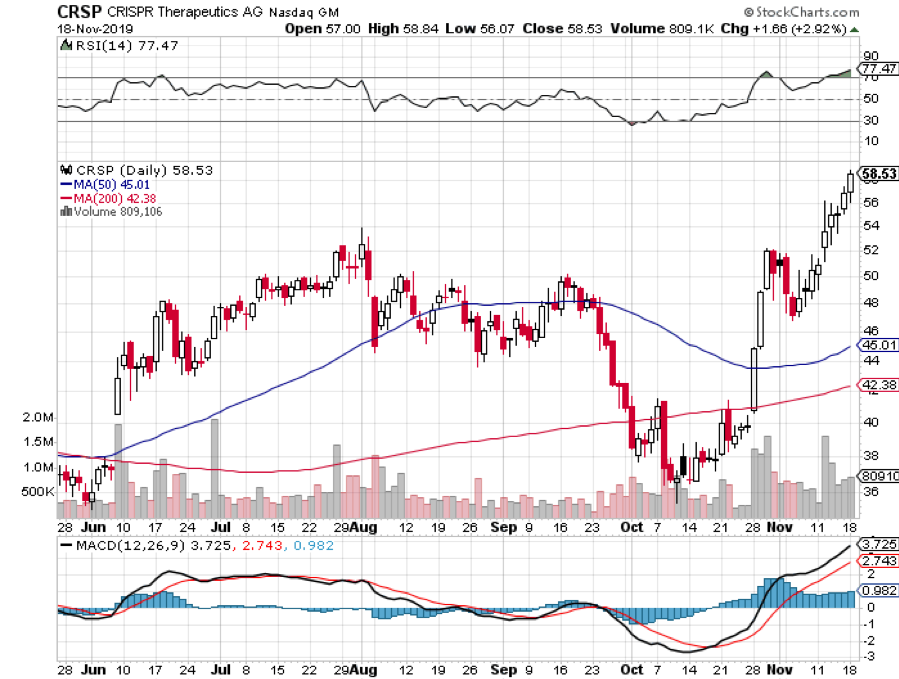
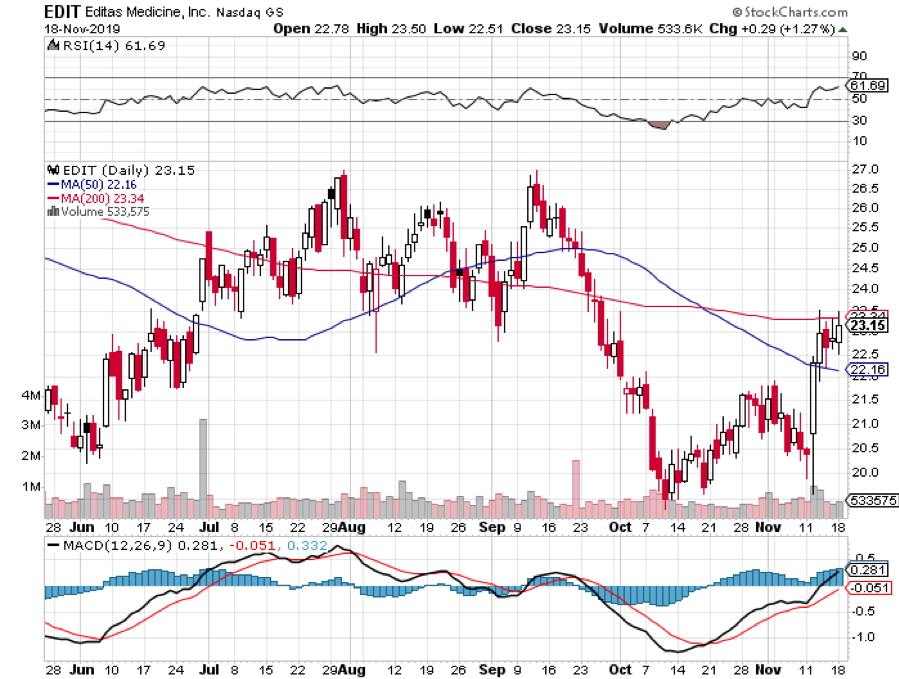

Mad Hedge Biotech & Healthcare Letter
November 14, 2019
Fiat Lux
Featured Trade:
JUMP ON THE ASTRAZENECA BANDWAGON
(AZN)

AstraZeneca plc (AZN) has shown a dramatic turnaround over the past three years, crushing its close competitors in the big biopharma landscape. Posting growth for the fifth straight quarter for both profit and sales, the stock has gained more than 10% in the run-up to its latest earnings report.
This pushed the company’s total stock market gains for 2019 to a stellar 33.4%. From a forward-looking price-to-earnings perspective though, investors must remain cautious as the stock also now sports a high valuation.
One of the reasons for the stock’s soaring performance this year is the promising cancer drug lineup, which is the result of AstraZeneca’s risky move to splurge on the development of these products way back in 2014.
Now, although no hard data has been disclosed to the public to date, AstraZeneca’s oncology lineup has been pegged to give Merck & Co.’s (MRK) Keytruda and Bristol-Myers Squibb Co.’s (BMY) Opdivo a run for their money in the lucrative lung cancer drug market.
AstraZeneca is anticipated to release survival data by 2020, with its acquired company Pearl Therapeutics taking charge of testing the effectiveness of Imfinzi to treat non-small cell lung cancer. The robust competition presented by both Bristol’s Opdivo and AstraZeneca’s Imfinzi is projected to carve out $2.5 billion from the sales of Merck’s cash cow Keytruda from 2021 to 2028.
Aside from Imfinzi, AstraZeneca has also raked in increasing revenue from another NSLC drug Tagrisso and ovarian cancer medication Lynparza.
Sales of AstraZeneca’s cancer drugs jumped 48% to hit $2.3 billion in the third quarter of 2019. In the first half of the year, total revenue from the company’s oncology lineup alone soared 52% year over year.
AstraZeneca’s largest moneymaker at the moment, Tagrisso, contributed more than $1.4 billion in the first six months of the year, jumping by 86% compared to the same period in 2018. The surge brought about by this strong cancer drug lineup resulted in a 16% rise in the company’s earnings in the third quarter, hitting $6.1 billion.
While these results are impressive, AstraZeneca’s cancer drug sales have yet to reach their peak. As impressive as Tagrisso has been in the first half of 2019, the other two cancer drugs of the company are actually outperforming this product.
One is Imfinzi, which saw its sales skyrocket by 248% during the same period, raking in $633 million. Meanwhile, Lynparza sales practically doubled to reach $520 million.
While its US sales remain competitive with the company achieving 17% revenue growth, AstraZeneca’s initiatives to expand to the Chinese market have also started to pay off. In fact, earnings from this East Asian country account for almost a fifth of the company’s revenue.
Sales in China continued its positive streak, rising 40% to reach $1.28 billion. To sustain this momentum and strengthen its stronghold in the market, the company recently announced its move to invest $1 billion to develop healthcare startups in the Middle Kingdom. This makes AstraZeneca the latest biopharma behemoth to place a bet on the second-biggest pharmaceuticals market in the world.
With all these in mind, it’s almost impossible to handicap the long-term outlook for AstraZeneca. The company currently has an impressive nine-drug lineup all set to turn into blockbusters this year.
Although the loss of patent exclusivity for cardiovascular disease moneymaker Crestor definitely affected the company, its move to transform its cancer drugs into core growth drivers has been quite successful thus far.
Bolstering its pillars of growth is AstraZeneca’s focus on building on its high-value lung cancer lineup particularly on Imfinzi and Tagrisso. Its emerging cardiovascular drug line has also been garnering attention, making heart medication Brilinta and diabetes treatment Farxiga the next blockbusters for the company.
On top of these, AstraZeneca has been actively developing potent combinations involving mantle cell lymphoma treatment Calquence and Lynparza. Needless to say, the company’s clinical pipeline has presented itself as one of the most promising in the biotech world today.
From where things stand at the moment, AstraZeneca appears to be vindicated in fighting for its standalone strategy and pushing back from the $118 billion hostile takeover attempt of Pfizer in 2014.
In increasing its footprint in emerging markets, AstraZeneca has transformed itself into a biotech company with the potential to dominate the industry in the years to come.
Buy AstraZeneca with both hands on the next dip.
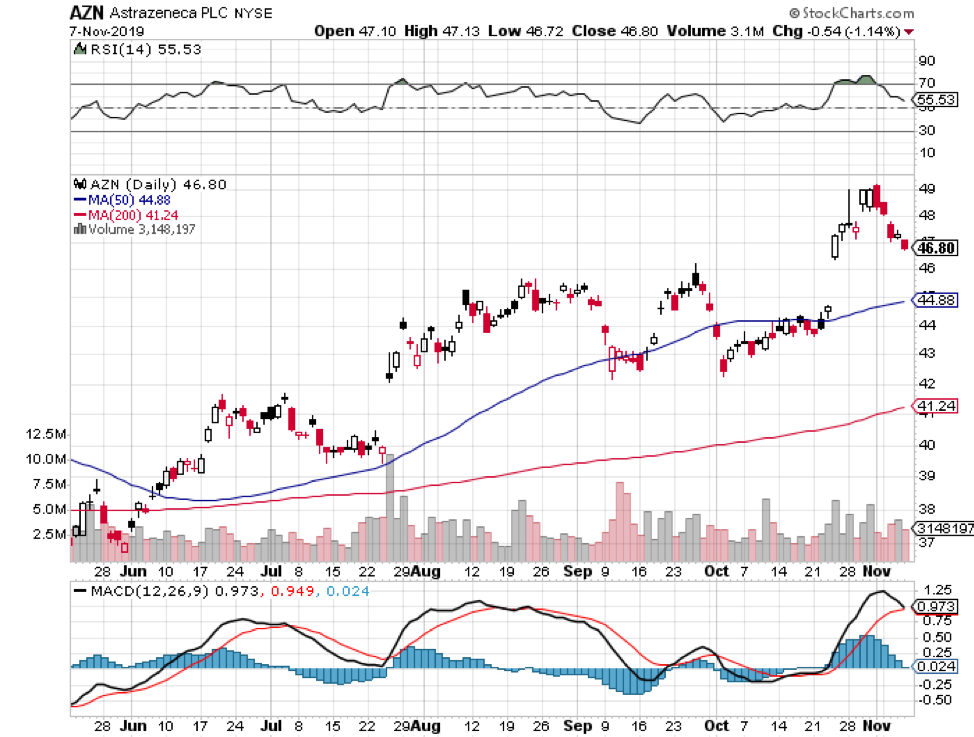
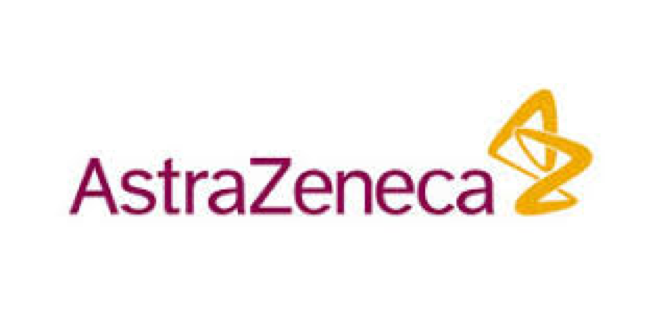
Mad Hedge Biotech & Health Care Letter
November 12, 2019
Fiat Lux
Featured Trade:
(MERCK SCORES BIG ON MELANOMA)
(MRK)

I am usually highly averse to buying shares at new all-time highs. The risk/reward is usually terrible.
However, I am going to have to make an exception in the case of Merck (MRK). I wait for a substantial dip to buy into which could last for a lifetime.
Merck shares have just broken out from their 17-year resistance level, which was set in stone in the low to mid-$60s for yonks following recent upbeat earnings estimates. The improvement in its performance has been mostly fueled by the expansion of its blockbuster cancer drug Keytruda.
With the recent success of drug’s campaign to be used in earlier melanoma treatment and even for HIV patients, it looks like Merck investors' fears of reduced exclusivity rights and price controls are all behind them now. Apart from these, Merck has managed to dodge the China trade war since life-saving medications are not likely to be included on Trump’s tariff list.
More power to Keytruda
Merck investors have constantly voiced out concerns over the company’s heavy reliance on Keytruda. However, it appears that there will be no change in the status quo anytime soon.
Earlier this year, Merck received FDA approval to offer Keytruda to metastatic small cell lung cancer patients. This translates to an expanded market for the already successful blockbuster drug and opens up a new avenue for the company to explore.
Prior to this, Merck announced its plan to acquire clinical-stage biotech company Peloton Therapeutics for $1.05 billion. This deal provides Merck with access to Peloton’s work on kidney cancer drugs and its marquee product, renal cell carcinoma treatment PT2977. This strategy, which was disclosed just days before Peloton’s scheduled IPO, exemplifies Merck’s aggressive pursuit of novel and innovative therapeutic candidates.
Apart from this, Merck has also announced its partnership with biotech firm Skyhawk Therapeutics. This deal, in which Skyhawk receives up to $600 million in upfront and potential milestone payments, grants Merck with the exclusive intellectual property rights for all their neurological disease and cancer studies.
Both acquisitions not only bolster Merck’s already promising oncology pipeline thanks to Keytruda’s success but also diversifies the company’s portfolio to cover other diseases.
Keytruda’s massive potential in China
While it has been widely considered that Keytruda lies at the heart of Merck’s success, it appears that the blockbuster drug has yet to reach the peak of its earnings potential. As impressive as it is at the moment, the current popularity of Keytruda could very well double or even triple in the future thanks to Merck’s efforts to tap into China’s cancer market. Needless to say, the success of this endeavor could easily translate into billions of additional sales.
Given the recent approval of Keytruda to tackle an expanded market, its move to cater to the Chinese population denotes significant revenue growth compared to how much they can earn from the US.
Keytruda is anticipated to earn roughly $5 billion in sales from the American market for its lung cancer indication alone. However, China’s much larger population, as well as the greater prevalence of the disease in that region, mean that Merck’s earnings for this drug could be 3.5 times higher than in the US. This estimate doesn’t even include other types of cancer prevalent in the Asian country like liver, breast, and gastric.
What to expect
Given all the moves made by Merck recently and the way its pipeline is shaping up courtesy of its acquisitions, it looks like the company is a prime candidate to rise in the near-term. In fact, Merck is projected to come up with better numbers in the next quarterly earnings report.
Riding the tailwinds of Keytruda’s success, Merck stock is projected to achieve year-over-year growth of 7.55%. Meanwhile, its earnings per share is estimated to hit $1.14. With the company shares rapidly approaching its average 12-month price target of $90.66, Merck is poised to continuously have a bullish outlook this year.
Buy (MRK) on this dip. It’s going to new all-time highs.
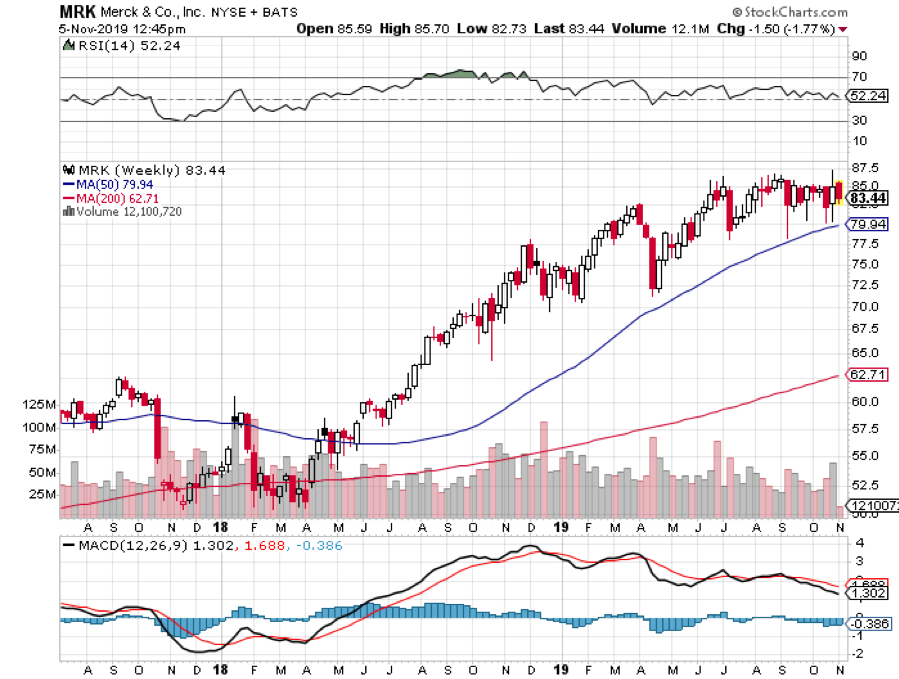
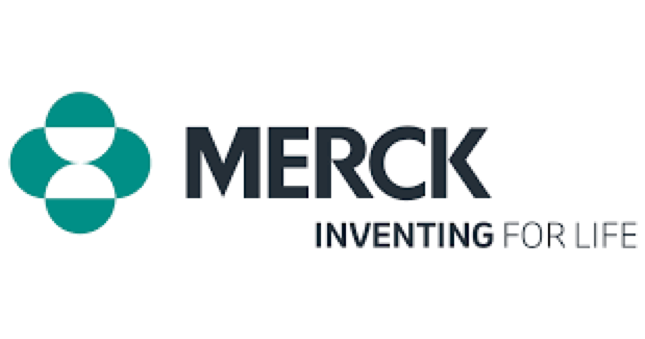
Legal Disclaimer
There is a very high degree of risk involved in trading. Past results are not indicative of future returns. MadHedgeFundTrader.com and all individuals affiliated with this site assume no responsibilities for your trading and investment results. The indicators, strategies, columns, articles and all other features are for educational purposes only and should not be construed as investment advice. Information for futures trading observations are obtained from sources believed to be reliable, but we do not warrant its completeness or accuracy, or warrant any results from the use of the information. Your use of the trading observations is entirely at your own risk and it is your sole responsibility to evaluate the accuracy, completeness and usefulness of the information. You must assess the risk of any trade with your broker and make your own independent decisions regarding any securities mentioned herein. Affiliates of MadHedgeFundTrader.com may have a position or effect transactions in the securities described herein (or options thereon) and/or otherwise employ trading strategies that may be consistent or inconsistent with the provided strategies.
This site uses cookies. By continuing to browse the site, you are agreeing to our use of cookies.
OKLearn moreWe may request cookies to be set on your device. We use cookies to let us know when you visit our websites, how you interact with us, to enrich your user experience, and to customize your relationship with our website.
Click on the different category headings to find out more. You can also change some of your preferences. Note that blocking some types of cookies may impact your experience on our websites and the services we are able to offer.
These cookies are strictly necessary to provide you with services available through our website and to use some of its features.
Because these cookies are strictly necessary to deliver the website, refuseing them will have impact how our site functions. You always can block or delete cookies by changing your browser settings and force blocking all cookies on this website. But this will always prompt you to accept/refuse cookies when revisiting our site.
We fully respect if you want to refuse cookies but to avoid asking you again and again kindly allow us to store a cookie for that. You are free to opt out any time or opt in for other cookies to get a better experience. If you refuse cookies we will remove all set cookies in our domain.
We provide you with a list of stored cookies on your computer in our domain so you can check what we stored. Due to security reasons we are not able to show or modify cookies from other domains. You can check these in your browser security settings.
These cookies collect information that is used either in aggregate form to help us understand how our website is being used or how effective our marketing campaigns are, or to help us customize our website and application for you in order to enhance your experience.
If you do not want that we track your visist to our site you can disable tracking in your browser here:
We also use different external services like Google Webfonts, Google Maps, and external Video providers. Since these providers may collect personal data like your IP address we allow you to block them here. Please be aware that this might heavily reduce the functionality and appearance of our site. Changes will take effect once you reload the page.
Google Webfont Settings:
Google Map Settings:
Vimeo and Youtube video embeds:
